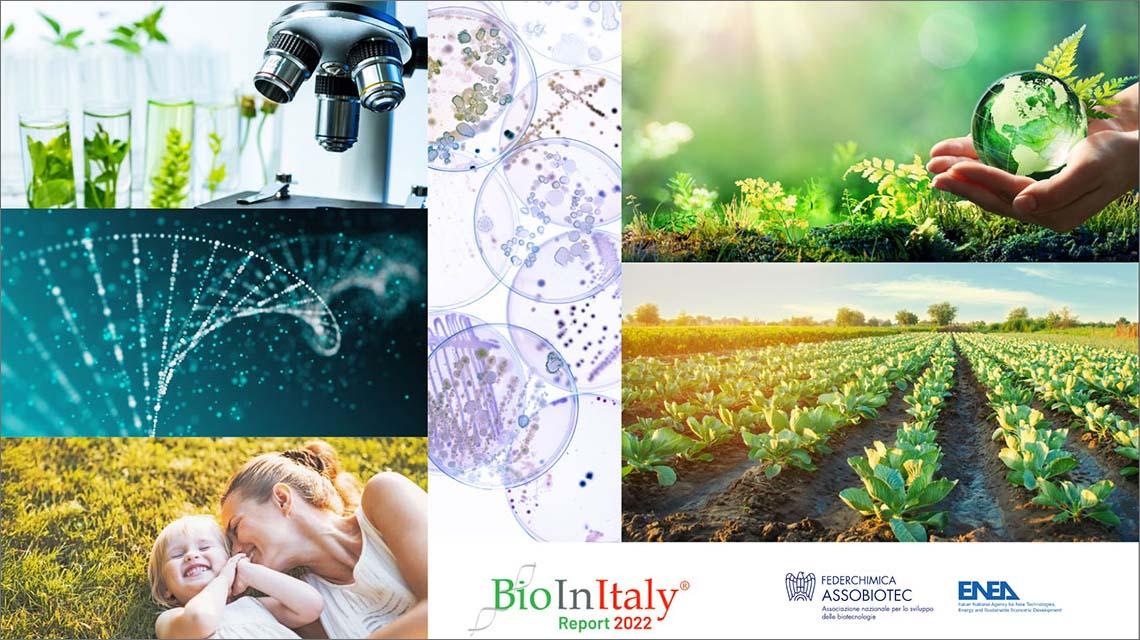Italian National Agency for New Technologies, Energy and Sustainable Economic Development

Innovation: ENEA and Assobiotec presented latest report on biotech industry in Italy
In figures: almost 800 companies, 13,000 employees, an over 10 billion turnover
Pandemic effect: companies dedicated to biotech R&D funded with Italian capital boosted turnover: + 30%. Investments in biotech R&D also grew: + 15%
The sectors: the period 2014 - 2021 showed a progressive and continuous growth in the number of biotech companies active in industry (+ 29%) and agriculture (+ 34.5%), but the main market remains the healthcare sector (48 , 5% of total enterprises)
At a regional level: Lombardy is leader in terms of number of businesses (27%) and turnover (51%). The biotech firms dedicated to industry are growing in the South and North East regions
A vivacious and vital sector, the engine of national innovation, capable of withstanding the impact of the pandemic crisis in all its areas of application and a significant increase in the number of companies dedicated to Italian-controlled biotech R&D, with a turnover that , in this sub-group of companies, recorded a + 30% in the black year of the global health emergency: this is what emerges from the annual report Assobiotec-Federchimica and ENEA “Biotechnology companies in Italy. Facts and Figures 2022”[1] which provides an accurate and in-depth view of the sector, outlining its main features over the last two years.
Based on the main data collected, the Italian biotechnology industry proves to be a sector with a stable, if not slightly growing population of companies, with a high R&D intensity and peaks of excellence in all fields of application.
The number of companies, after a slight decline at the end of 2020, less than 1% (the general decline in companies was more than double in the same year), in fact, returned to grow in 2021, exceeding the level reached at the end of 2019. The growth interested all areas of biotechnology application, particularly the companies dedicated to research and development in Italian-controlled biotechnologies, driven by those with prevalent application in industrial biotechnologies, with + 9% of companies among 2019 and 2020. The sector is characterized by small and micro enterprises that account for just over 82% of the total.
The turnover in 2020, the year in which the impact of the health emergency linked to Covid-19 was at its peak, showed a substantial stability, with a 5% decrease compared to 2019, equal to less than half of the whole Italian industry turnover (-12%). Especially significant in this sense is the strong and continuous growth that instead characterized the turnover of the “dedicated”[2] biotech companies under Italian control, which recorded a + 30%.
Considering the total number of companies, about three quarters of the total turnover is generated by the health sector, a considerable 17% by the industry and environment sectors. In fact, companies active in the field of human health continue to account for the greatest share of the total number of Italian biotechnology companies. However, the trend showing aprogressive and continuous growth in the number of companies active in industrial biotechnology (+ 29% between 2014 and 2021) and, especially in the last period, of those dedicated to agriculture and animal husbandry (+ 35% in the same period) was confirmed.
At a regional level, Lombardy, and in general the northern regions, confirm themselves as being a pole of primary importance for biotech production and turnover but, in recent years, there has been a progressive diffusion across the national territory of biotech production with a marked growth in the regions of the South and the North East.
As regards investments in research and development (R&D), “dedicated” companies showed an acceleration in 2020 compared to the immediately preceding years, with an increase of 7% on 2019 driven by companies with a prevalent application in human health and industry. Also for investments in biotech R&D, the growth recorded by companies dedicated to biotech R&D was greater than the average for the sector, with a + 15% in 2020 compared to 2019.
According to the questionnaires, the capital to fund companies active in biotechnology in Italy comes mainly from the resources made available by the owners in the form of retained earnings and of capital contributions by shareholders, depending on the structure and size of firms. The data gathered between 2017 and 2020 reports a growth in risk capital investments (Venture capital, Private Equity and Business Angel), a figure consistent with what shown by specialized sector studies (AIFI Report). The role of grants and non-repayable grants remains very important and more and more companies- mostly medium-large sized and active in human health- said they benefit from them (in 2020 over 30%).
COMMENTS
Elena Sgaravatti, Vice President Assobiotec - Federchimica
“Perhaps not everyone knows, but biotechnology is behind all responses to the pandemic crisis: from the sequencing of the virus genome to molecular diagnostics, from vaccines to monoclonal antibodies and antivirals, everything is biotech related. Today, at the end of the health emergency but in the face of new, urgent, dramatic needs like sustainable economic growth, diversification and expansion of energy sources but also the ability to supply raw materials for human and animal nutrition, biotechnology can once again play a crucial role. The PNRR is an extraordinary opportunity for our Country to restart and we cannot afford to make mistakes now. Choosing to initiate reforms and investing the resources of the Next Generation EU on innovation means leading the country towards a better future and biotech is certainly a technology that, in this perspective, cannot be neglected ".
Gaetano Coletta, Head of ENEA "Supply and Valorisation of Innovation Services"
"The new data in the Report not only confirm the resilience of the biotechnology sector in Italy in 2020, the hardest year of the pandemic crisis linked to COVID-19, but also highlight a further increase in R&D investments. This sector confirms itself as a driver of national innovation, increasingly crucial to respond to the new challenges that our society is facing, such as the health emergency, environmental sustainability and energy dependence. Furthermore, the growth of biotechnologies for human health, industry, the environment and agriculture continues, sectors in which, like ENEA, we make skills, technologies, infrastructures and advanced services available to companies and their associations " .
For more information:
The unabridged report is available at: https://bit.ly/ReportBiotech2022
Francesca Pedrali – Communication and Media Relations - Email:
